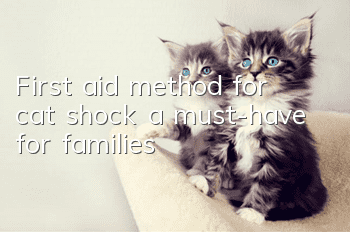First aid method for cat shock, a must-have for families!

How to give first aid to a cat that is in shock?
First aid for a cat that is in shock is a must-have for families! Although we always hope that our cats will have no serious illnesses and live a safe life, but in some irresistible situations Under the influence of drugs or usual negligence, cats may still encounter some unexpected situations, such as injuries or diseases. If they encounter particularly serious situations, cats may also go into shock. Shock is a very serious symptom, and the consequences will not be dealt with in time. It is unimaginable, but owners are often at a loss at this time due to lack of experience. So, how should we provide first aid to cats after shock?
When you find an unconscious cat, you should first get it out of danger and then take it to a veterinarian immediately. Use a blanket as a stretcher, lay the cat flat and gently place it on the blanket. Ask someone to help you carefully lift the blanket and place it on a stable surface. If your cat is having trouble breathing, lay her on her side with her head down. Open its mouth and pull its tongue forward. Use cotton wool to gently wipe away mucus from your mouth. Do not let the cat lie on its side for more than five to fifteen minutes, and do not feed it any food. When you take your cat to the vet, lower the blanket into a secure crate or box.
1. Shock first aid
Principle: Maintain blood and oxygen supply to important organs
1. Clear the airway
2. Give oxygen
3. Open intravenous channels
4. Keep those with low temperature warm and those with high fever physically cool down
2. Different causes Rescue methods
① Cardiogenic shock:
1. Remove the cause
Correct arrhythmia, digitalis 0.03-0.1mg/kg /day (dog); 0.005-0.015mg/kg (cat)
Myocarditis, intravenous infusion of hydrocortisone (2.5-5mg/kg)
2. Anti-shock: expansion Increase blood volume, increase cardiac output, and improve microcirculation. Crystalloid, colloid, dopamine, sodium nitroprusside
3. Other drugs: glucocorticoids, furosemide
②Anaphylactic shock:
1. Intramuscular injection of epinephrine 0.1mL/kg (0.1mg/mL)
In case of cardiac arrest, external chest cardiac massage or intracardiac injection of epinephrine can be performed
2. Hydrocortisone or dimethacin Dexamethasone (4-6 mg/kg) intravenously
3. Dyspnea: use nixamib, lobeline, etc.
③Hemorrhagic (hypovolemia) shock:< /p>
1. Expand blood volume (salt first, then sugar): dextran, plasma, albumin, blood transfusion
2. Stop bleeding
3. Drugs: alkaline solution , to correct acidosis; glucocorticoids to improve stress ability and relieve toxemia symptoms; use cardiovascular drugs as appropriate.
④ Traumatic shock: analgesia, bandaging, fixation, visceral ruptureEarly detection of fissures
⑤Burn shock:
Supplement blood volume (crystalloids, albumin)
Correction of acidosis (alkaline fluids)
Maintain renal function: Give diuretic 20% mannitol 0.25-0.5g/kg after replenishing fluids
⑥Septic shock:
1. Expand blood volume< /p>
2. Control infection and clear lesions
3. Drugs:
Correct acidosis (alkaline solution)
Improve stress ability , relieve symptoms of toxemia (glucocorticoids)
Use cardiovascular drugs as appropriate.
3. Other first aid methods for shock
During heat stroke, the cat will drool constantly, breathe quickly and difficultly, and the head will be hot and appear half-cold. Confused, try to cool down first. Wet the whole body, pour ice cubes or cold water on it, and then rush to the hospital. Don't cool yourself down for too long. Improper first aid may lead to hypothermia. Take the rectal temperature at any time. If the temperature is too low, keep it warm immediately.
When receiving an electric shock, check for signs of shock, carefully unplug the power source, and check for heartbeat and breathing.
When suffocated, the cat will scratch its mouth and throat with its feet, its tongue will be pale and purple, and it will be semi-conscious. Immediately open your mouth, pull out your tongue, hold your hind legs, stand upside down, pat your back, press your abdomen, and check your breathing and heartbeat at the same time.
When there is a sudden convulsion or spasm, put a cloth into its mouth and pull it away from the furniture to prevent it from being injured. Wrap the whole body in a towel or blanket and get to the hospital as soon as possible.
- A cat will die if it urinates for a few days
- Should you deworm yourself or go to a pet store?
- Are cat teasers harmful to cats?
- What should I do if my cat suffers from chronic gingivitis?
- Cat's nails are cracked with a thin layer
- Cats go crazy after eating mutton
- What does cat moss on a cat’s chin look like?
- Can cats reproduce after abdominal transmission is cured?
- What exactly is the sterilization shot for female cats?
- Can I still eat unopened cat food if it has expired?



